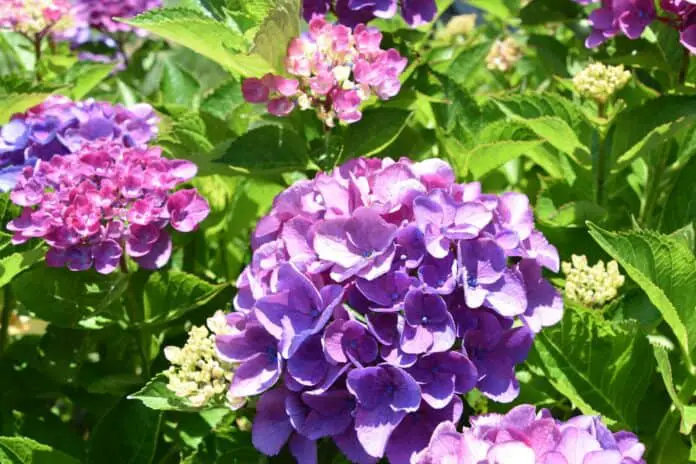
Yewhort is reader-supported. When you buy through links on our site, we may earn an affiliate commission.
Hydrangeas are beloved for their stunning blooms and lush foliage, but one common question gardeners often ask is: can hydrangeas take full sun? The answer depends on the type of hydrangea and the specific conditions of your garden. Let’s dive into the details to help you ensure your hydrangeas thrive in your sunny spots.
Understanding Hydrangea Varieties
Different hydrangea species have varying tolerances to sunlight. Here’s a quick overview of the most common types:
1. Panicle Hydrangea (Hydrangea paniculata)
- Sunlight Needs: Panicle hydrangeas are the most sun-tolerant. They thrive in full sun to partial shade.
- Ideal Conditions: These hydrangeas produce large, cone-shaped flowers and are less prone to wilting in direct sunlight.
- Popular Varieties: ‘Limelight’, ‘Quick Fire’, and ‘Little Lime’.
2. Smooth Hydrangea (Hydrangea arborescens)
- Sunlight Needs: Smooth hydrangeas can handle full sun, especially in cooler climates, but they prefer partial shade in hotter regions.
- Ideal Conditions: They are adaptable and hardy, known for their large, white flower heads.
- Popular Varieties: ‘Annabelle’ and ‘Incrediball’.
3. Bigleaf Hydrangea (Hydrangea macrophylla)
- Sunlight Needs: Bigleaf hydrangeas prefer morning sun and afternoon shade. They can suffer from leaf scorch and wilting in full sun, especially in hot climates.
- Ideal Conditions: They thrive in partial shade with consistent moisture.
- Popular Varieties: ‘Endless Summer’ and ‘Nikko Blue’.
4. Oakleaf Hydrangea (Hydrangea quercifolia)
- Sunlight Needs: Oakleaf hydrangeas prefer partial shade but can tolerate full sun if they have adequate moisture.
- Ideal Conditions: They have unique, oak-shaped leaves and beautiful fall color.
- Popular Varieties: ‘Snow Queen’ and ‘Ruby Slippers’.
Factors to Consider
When deciding whether to plant hydrangeas in full sun, consider the following factors:
1. Climate
- Cooler Climates: Hydrangeas can generally handle more sun in cooler climates. Full sun in these regions can help promote vigorous growth and abundant blooms.
- Hotter Climates: In hot, sunny climates, hydrangeas may suffer from heat stress and require afternoon shade to prevent leaf scorch and wilting.
2. Watering
- Hydrangeas in full sun need more frequent watering, especially during hot, dry periods. Ensure the soil remains consistently moist but not waterlogged.
3. Soil
- Well-drained, fertile soil is essential. Mulching around the base of the plants helps retain moisture and regulate soil temperature.
Tips for Growing Hydrangeas in Full Sun
If you decide to plant hydrangeas in a sunny spot, here are some tips to ensure they thrive:
1. Choose the Right Variety
- Opt for sun-tolerant varieties like Panicle and Smooth hydrangeas if you have a sunny garden.
2. Water Regularly
- Hydrangeas need consistent moisture, especially in full sun. Deep watering once a week is better than frequent shallow watering.
3. Mulch Generously
- Apply a 2-3 inch layer of mulch around the base of the plants to retain moisture and keep roots cool.
4. Monitor for Stress
- Watch for signs of heat stress, such as wilting or scorched leaves, and provide shade during the hottest part of the day if necessary.
Conclusion
Hydrangeas can indeed take full sun, but their success depends on the variety and growing conditions. By selecting the right type of hydrangea and providing adequate water and care, you can enjoy their beautiful blooms even in the sunniest parts of your garden. Happy gardening!
Feel free to pin this guide and share it with fellow garden enthusiasts. Let’s make our gardens bloom beautifully, no matter the sunlight!






